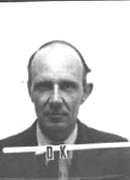Egon Bretscher (1901-1973) was a chemist and nuclear physicist and was involved in the British atomic bomb effort. Egon Bretscher was born in Switzerland in 1901. He received his PhD in organic chemistry at Edinburgh in 1926.
In 1936 Bretscher came to work at the Cavendish Laboratory in Cambridge under Ernest Rutherford, where he started working on nuclear fission. His partnership with fellow scientist Norman Feather proposed that the 239 isotope of element 94 could be produced by uranium-238 and that should be able to sustain a nuclear chain reaction. The outbreak of the Second World War led Bretscher to join the ‘Tube Alloys’ Project at Cambridge. Tube Alloys would become to be known as the code name for the British atomic project during the duration of WWII. During his time on this project, he worked on plutonium-separation chemistry and fission cross sections.
Bretscher was one of the leaders of the British Mission to be stationed at Los Alamos from 1944-46 where he worked with Enrico Fermi. During his time at Los Alamos, he made measurements on the energy released in the fusion process. It was also during his stay at Los Alamos that Bretscher took Kodachrome slides with uniquely colored records of the site. [View some at the gallery below. For a further look, the photos are held by the Churchill Archives Centre].
In 1947 after returning to Britain, he became a Division Head at the Harwell Laboratory (also known as the Atomic Energy Research Establishment), where he stayed until his retirement in 1966.
The efforts of Bretscher during his time as a Division Head contributed to a strong program in basic nuclear research at Harwell, that continues to this day.
Egon Bretscher died in 1973, leaving behind two daughters and three sons.
[Egon Bretscher is mentioned in the following Voices of the Manhattan Project interviews: Anthony French, Lew Kowarski, Emilio Segre]





